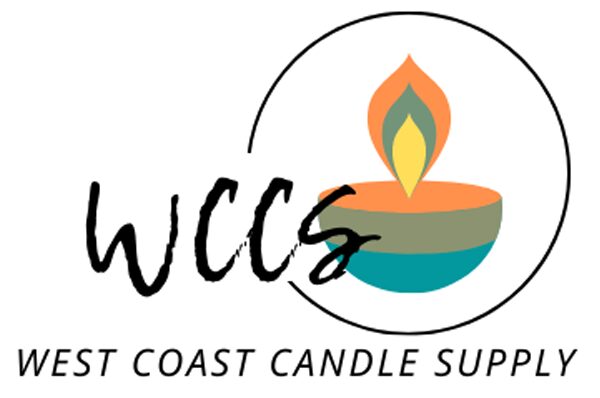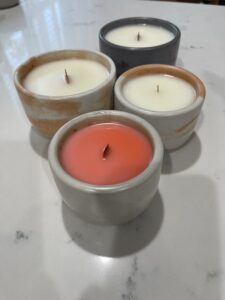We all love candles, but why do we want natural waxes in our candles? What makes them different or better? We know that candles have to use wax as their mode of keeping the wick from burning out quickly, it slows the process to burn evenly and also to distribute the fragrances that we desire from our candles. There are many kinds of wax for your candles: There is paraffin, soy, coconut and beeswax, but we are going to break them down and tell you why we use the natural waxes. Why does a candle maker have a slight heart attack if you ask them to try another kind of wax? Why do new candle makers want to try every single kind of wax and make 20 different kinds of candles? Honestly, we all have our reasons, and many people will share in that feeling but there are a lot of scientific deductions for each kind, but I will cover what my feelings are and my understanding of each one.
Paraffin Waxes are the most common in your store bought candles, or we can call them the grocery store candles. Paraffin wax is inexpensive and a very good mode of distributing Fragrance oils. Paraffin is probably the best wax for hot throw ( the hot throw is the fragrance release when the candle is burning). Paraffin wax is a soft colorless solid wax that is made from saturated hydrocarbons. Paraffin wax is a by-product of petroleum, and for this reason some people are very against using it in their homes. Paraffin wax will hold a high volume of fragrance oils and colors, thus it is used in most grocery store candles…think about it, they are usually colorful and scented nicely. You can have a significant amount of sooting from paraffin candles, this is a not so great attribute of paraffin.
Soy wax is the next wax that is widely used in production candles. Soy waxes are natural and not a petroleum by product, they hold a nice level of fragrance oils and burn slower than paraffin candles, which means you candle with last longer with soy waxes. There are some drawbacks of soy waxes, they do tend to expand and contract more than paraffin, this can show in your vessels along the sides. They can also frost which means that it can have a white discoloration on the top or sides of your wax, if you use a clear glass vessel, this is noticeable. Soy wax is sustainable and renewable, it burns much cleaner than paraffin. Soy is not as susceptible to soot as paraffin wax does, it also will burn more thoroughly than paraffin, which means less wasted product. Soy wax candles tend to be more economical than some of the natural wax candles, this is good for saving your dollars.
Coconut Wax is the our next wax on the docket. Coconut wax is a natural product that is clean burning and burns even slower than soy. So, this means that your coconut wax candles are going to be around for a long time! Coconut wax is sustainable and renewable, some will argue that coconut is more sustainable than soy…I feel both are natural renewable products. Coconut burns even cleaner than soy waxes, so this means even less sooting or bad things in your air, which is always good for our personal health! Coconut waxes are a bit harder to find the sweet spot for wicking and fragrance oil percentages but once you figure out the formula for your candles it is a sweet spot and they are wonderful. With that said…wicking can be a bit tricky and for this reason, I usually do not recommend a new candle maker to start right out the gates in coconut wax, but you can blend it with Soy wax to make it a better option. Coconut wax has a creamy texture and pours with a creamy finish.
Last but not least we have Beeswax, which is the most natural, sustainable and renewable wax that there is, let’s give credit to the bees who work their tails off to make this wax! By far, beeswax is the most expensive and it is one of the best for making a candle. Beeswax has its pros and cons as do all of the natural waxes. Beeswax contracts when it is used in containers, you can see gaps on the side of your candle vessel. Beeswax is in my opinion, the best for hot throw and cold throw, beeswax candles are so very fragrant and remain fragrant month after month. Due to its contracting, beeswax is great when you mix it with a softer wax such as Coconut or Soy, this makes a great combination of natural waxes, hot and cold throw are great and you will have less contraction in a container. Straight beeswax candles can be very difficult to wick, beeswax burns very hot and it needs a much larger wick than you will use in soy or coconut waxes. Once you figure out this wicking issue you will LOVE your beeswax candles. Beeswax is the most expensive of the natural waxes, so that can also lead a candle maker to blend it with other natural waxes. Bees wax does not have a curing period, you can enjoy your beeswax candles immediately, whereas coconut and soy waxes need to cure for 2 weeks to set up and be at their most fragrant. One drawback is that beeswax is messy, it is a lot like paraffin with the clean up! I find that when you mix it with coconut that problem is gone.
As a candle maker and a wholesale candle supplier, I love to blend waxes! I can make different blends that make a wonderful smelling natural wax candle, but for many reasons. For example, I use a soy-coconut blend when making a wood wick candle, this is much easier to control the wicking, since soy burns slower than coconut wax. I use Beeswax and Coconut blend to make a luxury candle with our high end fragrances and this is the perfect blend to highlight a beautiful high quality fragrance oil. You may find that perfect blend that has the right combination for the right reasons, such as your environment, if you live in a hot climate you may want to add in beeswax or soy to give you a more stable wax in the hot temperatures?
I hope that this was some insight on the wonderful world of natural waxes, and as always, everyone has a different opinion or need and will find a perfect blend for themselves. I wish you luck on your candle journey and you can always reach out to me if you have any questions.
Tracey

